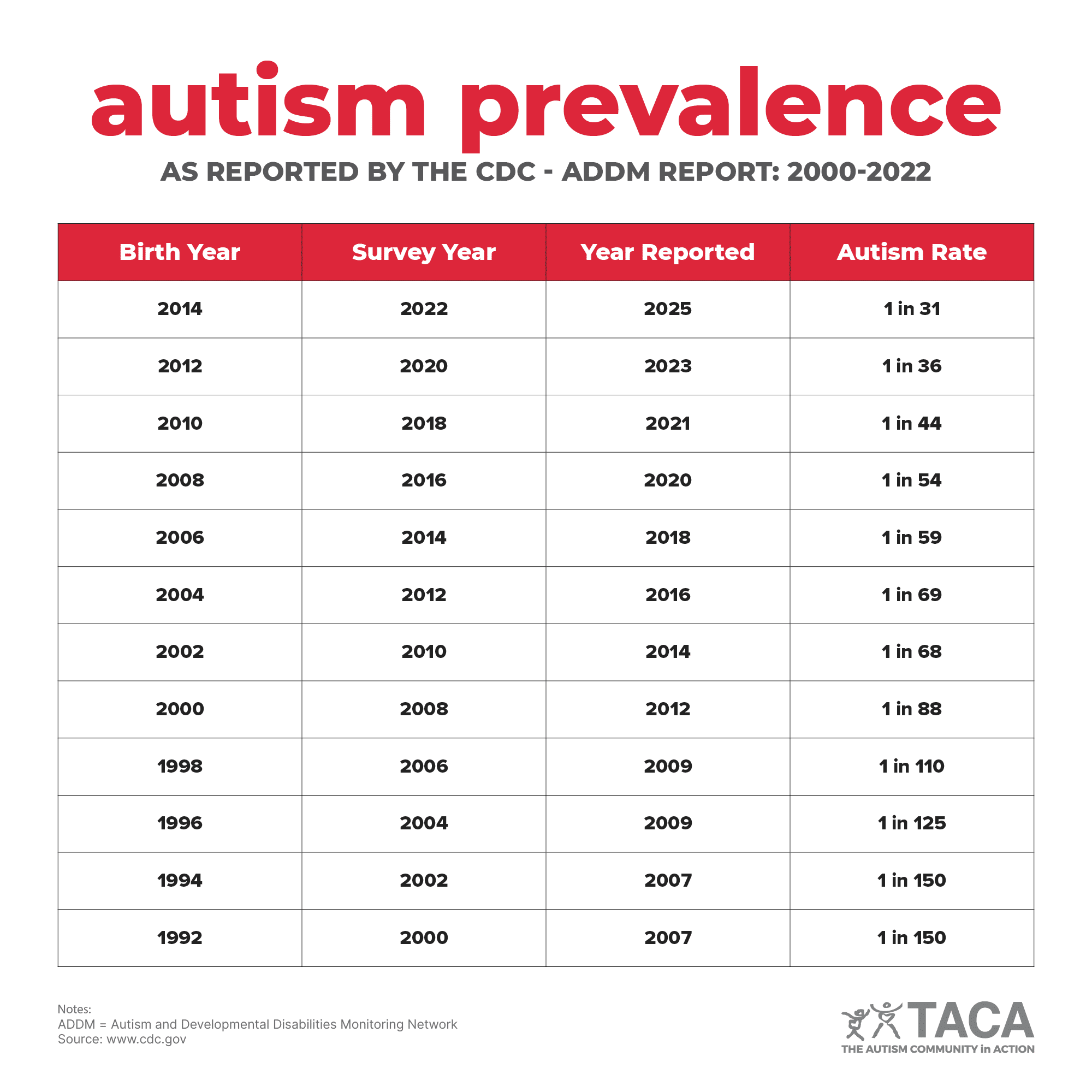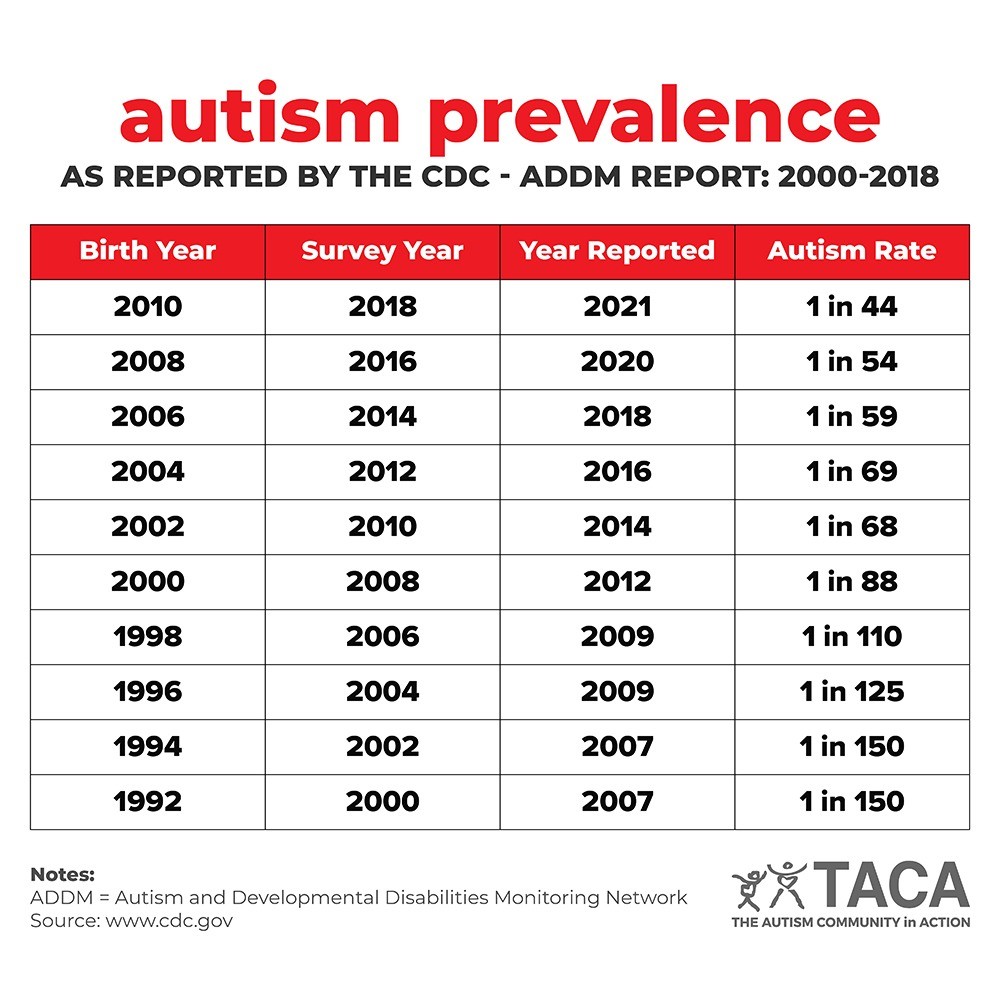prevalence
The CDC tracks autism prevalence in the U.S. to better understand the scope and impact autism has upon children, families, and communities. Additionally, service providers and organizations use these findings when preparing to meet the support needs of the families they serve.
This is key information from the CDC's most recent autism prevalence report, as well as answers to some frequently asked questions about autism prevalence.
Current Autism Prevalence in the US
The newly released report by the CDC estimates that 1 in 31 children have autism in the United States, indicating a 384% increase in autism prevalence since 2000 when autism prevalence was 1 in 150.
Additional findings from the CDC's report show that:
- Most children are still diagnosed after the age of 4 even though they can be reliably diagnosed by age 2
- Boys are more than 4 times more likely to be identified with autism than girls
- While progress has been made to close racial and ethnic gaps in identifying those with autism, disparities still remain:
-
- Prevalence rates are similar between white and black children, but significantly lower for Hispanic children
- Black children with autism are less likely to be evaluated by age 3 than white children, and more likely to go without a diagnosis by 8 years

FAQs
While the cause of autism remains unclear, current studies show genetics and environment both play a role. The CDC also acknowledges that there are "many different factors that make a child more likely to have an ASD, including environmental, biologic and genetic factors," which is why they have launched the SEED study to learn more about the risk factors and causes of autism.
No. While it is true that the definition of autism was expanded to include PDD-NOS and Asperger's, the CDC states that:
"It is unclear exactly how much of this increase is due to a broader definition of ASD and better efforts in diagnosis. However, a true increase in the number of people with an ASD cannot be ruled out. We believe the increase in the diagnosis of ASD is likely due to a combination of these factors.
We do know that ASD are more common than we thought before and should be considered an important public health concern. There is still a lot to learn about ASD. In addition, increased concern in the communities, continued demand for services, and reports estimating a prevalence of about 1.7 percent show the need for a coordinated and serious national response to improve the lives of people with ASD.”
National Center on Birth Defects and Developmental Disabilities, Centers for Disease Control and Prevention. (2019) Frequently Asked Questions: Is there an ASD Epidemic? Retrieved from www.cdc.gov/ncbddd/autism/topics.html.
The prevalence rate that is considered “official” is the one that is released by the CDC. Other organizations, such as the National Survey of Children’s Health (NSCH) and the National Health Interview Survey (NHIS), use different methods to collect their data and look at different age groups when determining prevalence rates. This is why their autism prevalence rates differ from the CDC’s.
Prevalence rates are not a census. They do not represent the entire population of children with autism in the United States. They are an estimate based on a sampling of communities throughout the United States.
The CDC calculates autism prevalence based on the following data:
- Health and special education records of 8-year-old children
- These records were collected from specific sites located in Arizona, Arkansas, Colorado, Georgia, Maryland, Minnesota, Missouri, New Jersey, North Carolina, Tennessee, and Wisconsin.
![]()
The CDC collected the data to determine the current rate back in 2018. It takes the CDC about 4 years to analyze the data and release a new prevalence rate.

reports
The CDC’s website contains a lot of information. Because of this, it can be difficult, if not impossible, to navigate and find what you’re looking for. Who wants to spend hours and hours searching for old reports? We sure don’t! Since we’re fairly confident that we aren’t the only ones who feel this way, we’ve collected and archived all of the CDC’s autism prevalence reports in one, easy-to-find location for you.
Remember, it takes the CDC about four years to analyze data and release a new prevalence rate. Be sure to take the survey versus the reporting year into consideration when searching the reports.

